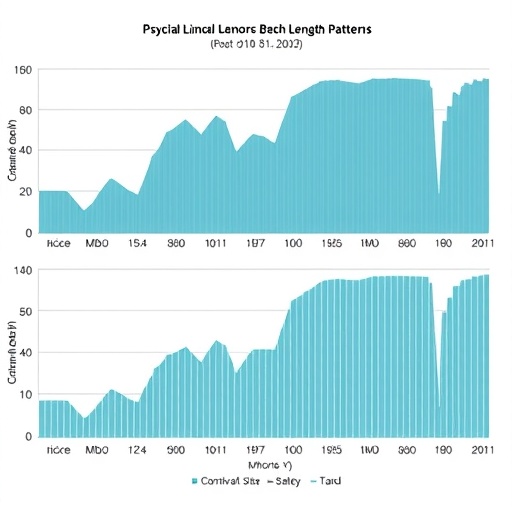In the complex realm of psychiatric care, understanding how long patients remain hospitalized is essential for optimizing treatment strategies and efficiently allocating healthcare resources. Traditionally, length of stay (LoS) distributions across medical fields have been regarded as right-skewed, where a majority of patients experience short hospitalizations, and a smaller subset undergo extended stays. However, groundbreaking research from the University Hospital of Psychiatry Zurich challenges this simplistic view, revealing a more intricate bimodal pattern in psychiatric inpatient durations that could revolutionize mental health care delivery.
Conducted over a span of seven years from 2013 to 2020, the extensive study analyzed nearly eighteen thousand hospital admissions, meticulously categorizing LoS according to diagnostic groups based on established International Classification of Diseases-10 (ICD-10) standards. The comprehensive retrospective cross-sectional analysis employed both linear and logarithmic visualizations to dissect the distribution nuances that previously went unnoticed in psychiatric populations.
What stands out in these findings is the emergence of two distinct clusters within psychiatric hospitalization data. Visualized on a logarithmic scale, the LoS distribution manifests as bimodal, illustrating clear separations between short-term stays—ranging from one to ten days—and significantly longer stays extending from eleven to two hundred days. This division not only highlights diverse treatment trajectories but also implies fundamentally different therapeutic needs within the inpatient population.
The short-stay group predominantly reflects patients undergoing rapid crisis interventions. These hospitalizations are focused on immediate stabilization and acute symptom management, typically serving individuals grappling with intense but transient episodes of distress. In contrast, the long-stay group corresponds to those requiring protracted therapeutic care, encompassing complex, chronic, or severe mental health conditions that necessitate sustained multidisciplinary intervention.
Fascinatingly, this bimodal distribution is not uniform across all psychiatric diagnoses. Disorders such as anxiety and stress-related conditions, alongside major depressive disorder, exhibit the most pronounced dual peaks. This suggests that these conditions admit substantial variability in the acuity and complexity of episodes treated in inpatient settings, accommodating both brief crisis care and extended stabilization efforts.
Conversely, certain diagnostic categories display a propensity towards extended hospitalizations. Patients diagnosed with schizophrenia spectrum disorders, organic mental disorders, and bipolar disorders are statistically more likely to fall within the long-stay cluster. These groups often contend with persistent symptomatology, cognitive impairments, or fluctuating mood states that complicate swift discharge and require intensified therapeutic engagement.
Beyond diagnostic distinctions, the study uncovers meaningful demographic and clinical differences between the two LoS cohorts. Long-stay patients not only present with higher Health of the Nation Outcome Scales (HoNOS) scores—indicating greater symptom severity and functional impairment—but are also significantly older on average. This convergence of increased age and clinical burden underscores the necessity for tailored care programs that address the nuanced profiles of prolonged hospitalizations.
The implications of these observations extend well beyond the academic domain, posing critical questions about current psychiatric care models. Recognizing that the treatment population divides into two fundamentally different subsets calls for differentiated care approaches. Health systems must balance resources to accommodate the rapid throughput of crisis care alongside the sustained therapeutic needs inherent to extended rehabilitation and stabilization.
Moreover, this bimodal perspective challenges policies that treat length of stay as a monolithic variable constrained predominantly by diagnosis. The study’s authors argue that factors transcending primary diagnosis—inclusive of patient age, symptom severity, and potentially social determinants—play critical roles in determining hospitalization duration. This insight supports the push for more personalized, dynamic care pathways that reflect the heterogeneity of psychiatric patient populations.
From a methodological standpoint, the use of logarithmic visualization marks a significant advance in elucidating underlying distribution structures. Traditional linear graphs, while pervasive, can mask important data features such as bimodality, which carry profound clinical and operational significance. The Zurich study thereby exemplifies the value of innovative analytical frameworks in mental health research.
These findings also bear relevance to broader health system design and policy formulation. As inpatient psychiatric care is resource-intensive, aligning treatment intensity with patient needs could lead to improved outcomes and cost efficiencies. The recognition of bimodal LoS patterns supports the development of tiered care infrastructures, including stepped-down facilities or community-based programs complementary to inpatient services.
Finally, the research encourages ongoing exploration into the drivers behind LoS variance, including psychosocial factors, comorbid medical conditions, and healthcare system variables. Such multifactorial analyses hold promise for refining predictive models and crafting interventions that minimize unnecessary hospitalization while ensuring adequate therapeutic support.
In sum, the revelation of a bimodal distribution in psychiatric inpatient length of stay signifies a paradigm shift in understanding hospital utilization patterns. By distinguishing between crisis-driven short admissions and complex, extended therapeutic engagements, this study lays the groundwork for more nuanced, equitable, and effective psychiatric care delivery in contemporary health systems.
Subject of Research: Length of stay distribution patterns in psychiatric inpatient populations and their clinical and demographic correlates.
Article Title: Crisis versus extended care: bimodal distribution of length of stay in psychiatric inpatients.
Article References:
Hofmann, A.B., Spiller, T.R., Rapaport, J.A. et al. Crisis versus extended care: bimodal distribution of length of stay in psychiatric inpatients. BMC Psychiatry 25, 711 (2025). https://doi.org/10.1186/s12888-025-07149-9
Image Credits: AI Generated




